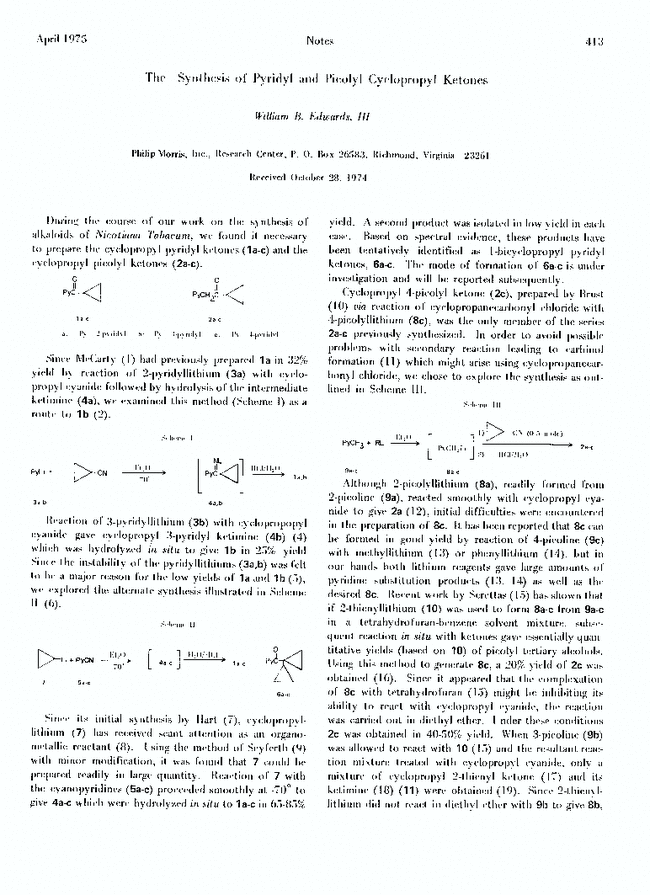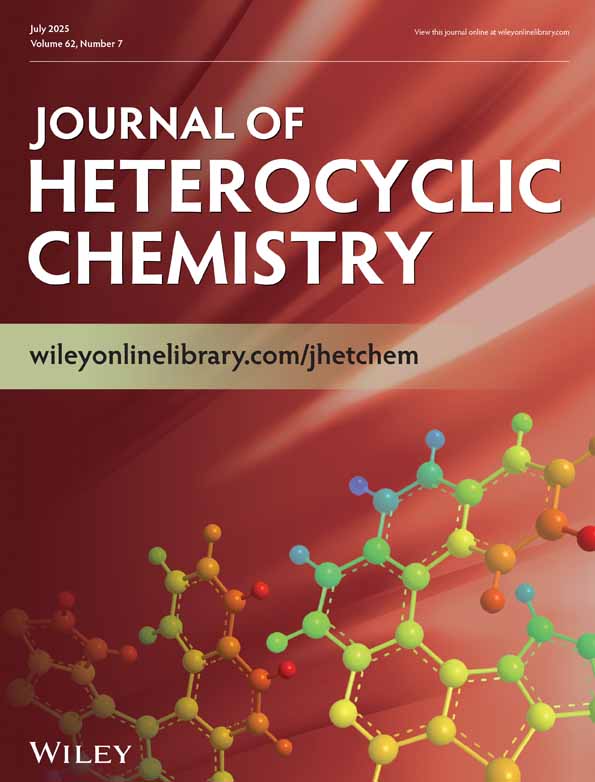Note
Full Access
The synthesis of pyridyl and picolyl cyclopropyl ketones
William B. Edwards III,
William B. Edwards III
Philip Morris, Inc., Research Center, P. O. Box 26583, Richmond, Virginia 23261
Search for more papers by this authorWilliam B. Edwards III,
William B. Edwards III
Philip Morris, Inc., Research Center, P. O. Box 26583, Richmond, Virginia 23261
Search for more papers by this author
References
- 1 F. J. McCarty, C. H. Tilford, and M. G. Van Campen, Jr., J. Am. Chem. Soc., 79, 472 (1957).
- 2 Breuer (3) reported 1b but did not describe a method or give physical data.
- 3 E. Breuer and D. Melumad, Tetrahedron Letters, 3595 (1969).
- 4 R. V. Stevens, M. C. Ellis and M. P. Wentland, J. Am. Chem. Soc., 90, 5576 (1968).
- 5 H. L. Yale, in “ Pyridine and Its Derivatives,” Volume XIV, Part II, E. Klingsberg, Ed., Interscience Publishers, Inc., New York, N. Y., 1961, pp. 422–3 and references cited therein.
- 6 A modified version of this synthesis for the preparation of cyclopropyl 3-pyridyl ketone (carbonyl-14C) has previously been reported in our laboratories by R. A. Comes, M. T. Core, M. D. Edmonds, W. B. Edwards, III and R. W. Jenkins, in J. Label. Compounds, 9, 253 (1973).
- 7 H. Hart, Chem. Ind. (London), 1014 (1956).
- 8 H. M. Walborsky, G. E. Niznik and M. P. Periasamy, Tetrahedron Letters, 4965 (1971). R. Magid and S. E. Wilson, Tetrahedron Letters, 4925 (1969). D. T. Longone and W. D. Wright, Tetrahedron Letters, 2859 (1969). H. Hart and R. A. Cipriani, J. Am. Chem. Soc., 84, 3697 (1962).
- 9 D. Seyferth and H. M. Cohen, Inorg. Chem., 2, 625 (1963).
- 10 B. Brust, R. I. Fryer and L. H. Sternbach, U. S. Patent 3,371,096 (1968). Chem. Abstr., 65, PC 544e (1966).
- 11 N. N. Goldberg, L. B. Barkley and R. Levine, J. Am. Chem. Soc., 73, 4302 (1951).
- 12 A 1:1:0.5 mole ratio of 9a, phenyllithium and cyclopropyl cyanide was employed (11).
- 13 C. Osuch and R. Levine, J. Am. Chem. Soc., 78, 1723 (1956).
- 14 J. P. Wibaut and J. W. Hey, Rec. Trav. Chem., 72, 513 (1953).
- 15 C. G. Screttas, J. F. Estham and C. W. Kamienski, Chimia, 24, 109 (1970). C. G. Screttas, U. S. Patent 3,691,174 (1972).
- 16 When benzophenone was used in lieu of cyclopropyl cyanide in a repeat of the original work (15), a 90% yield of 1,1-diphenyl-2-(4-pyridyl)ethanol was obtained.
- 17 Available from Aldrich Chemical Company, Inc.
- 18 Structure proof obtained by comparison with independently synthesized (from 10 and cyclopropyl cyanide) sample: b.p. 59–60° (0.06 mm.); ir (carbon tetrachloride): 3295 (NH) and 1610 cm−1 (CN); nmr (deuterochloroform): δ 0.95 (m, 4, cyclopropyl methylene), 2.15 (m, 1, cyclopropyl methine), 7.18 (m, 1, thiophene 4H), 7.56 (m, 2, thiophene, 3 and 5H), 8.74 (broad s, 1, NH). Anal. Caled. for C8H9NS: C, 63.5; H, 6.0; N, 9.3; S, 21.2. Found: C, 63.4; H, 6.0; N, 9.1; S, 21.4.
- 19 While it initially appeared that the hydrolysis rate of 11 to the corresponding ketone was unusually slow, a preliminary determination of the rate showed it to be of the order of 10−3 min.−1 at 25°. This rate is in line with what would be expected (20) and implied that the rate of hydrolysis for 4a-c and the cyclopropyl picolyl ketimines was unusually fast. This is currently being investigated.
- 20 J. B. Cloke, L. H. Baer, J. M. Robbins and G. E. Smith, J. Am. Chem. Soc., 67, 2155 (1945). J. B. Culbertson and L. Hines, Proc. Iowa Acad. Sci., 41, 172 (1934). Chem. Abstr., 29, 35828 (1935).
- 21 A. D. Miller and R. Levine, J. Org. Chem., 22, 168 (1957).
- 22 A. D. Miller, C. Osuch, N. N. Goldberg and R. Levine, J. Am. Chem. Soc., 78, 674 (1956).
- 23 Supplied by Columbia Organic Chemical Company, Inc., Columbia, South Carolina.
- 24 Because of the low solubility of 5c in ether, 800 ml. was required.
- 25 Transfer of the cyclopropyllithium solution to the addition funnel was carried out under argon using syringe needles and vacuum.
- 26 V. Ramanthan and R. Levine, J. Org. Chem., 27, 1667 (1962).




